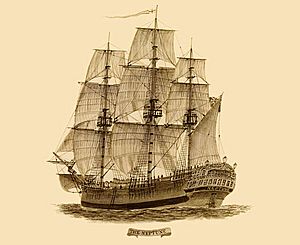Neptune (1780 ship) facts for kids
The Neptune was a large sailing ship built in 1780. It was known as a three-decker East Indiaman, which means it was a big merchant ship used for long voyages. The Neptune made five important trips for the British East India Company (EIC), a powerful trading company. On its very last journey, it carried many convicts (prisoners) to Port Jackson in Australia. This trip was part of the famous Second Fleet, and it was a very difficult and sad voyage for many people. The Neptune was later destroyed by a fire and explosion in 1796 near Cape Town, South Africa.
Contents
Voyages for the East India Company
The Neptune completed four long voyages for the British East India Company (EIC). These trips involved sailing across oceans to places like India and China to trade goods.
First EIC Voyage (1780-1783)
Captain Robert Scott led the Neptune on its first EIC trip. The ship left England in June 1780, heading for places like Madras, Bengal, and Bombay in India. It took a long time to reach these destinations, often stopping at places like Rio de Janeiro. The ship spent many months sailing around India, trading and delivering goods. Finally, after more than three years, the Neptune returned to England in August 1783.
Later EIC Voyages (1784-1789)
Captain George Scott took over for the next three voyages. These trips also involved long journeys to India and China.
- The second voyage (1784-1785) went to Bombay, India.
- The third voyage (1786-1787) sailed all the way to Whampoa in China.
- The fourth voyage (1788-1789) was another trip to China.
These voyages were important for trade, bringing valuable goods like tea and spices back to Britain. Each trip lasted well over a year, showing how long and challenging sea travel was in those days.
Journey to Australia with the Second Fleet
The Neptune's most famous, and most difficult, journey was as part of the Second Fleet to Australia. This fleet carried thousands of convicts from England to the new colony in Port Jackson.
The Convict Voyage (1789-1790)
Captain Thomas Gilbert began this voyage in November 1789. The Neptune sailed from England with two other ships, the Surprize and the Scarborough, on 19 January 1790. On board the Neptune were 421 male and 78 female convicts. During the trip, Captain Gilbert died, and Donald Traill became the new master of the ship.
The ships stopped at the Cape of Good Hope in South Africa to get supplies. They also picked up 12 male convicts from another ship, HMS Guardian, which had been damaged. The journey was very rough, and the Neptune and Scarborough got separated from the Surprize. The Neptune finally arrived at Port Jackson, Australia, on 28 June 1790. The trip had taken 160 days from England.
Harsh Conditions and Sickness
The conditions for the convicts on board the Neptune were extremely harsh. Many convicts were kept chained below deck for the entire journey. Food was scarce and often poor quality. Diseases like Scurvy were common because of the lack of fresh food and poor hygiene.
Sadly, 147 male and 11 female convicts died during the voyage on the Neptune. This was a very high death rate, about 31% of all the convicts on board. When the ship arrived, more than half of the surviving convicts (269 out of 530) were sick. The Neptune had the second highest death rate of all the convict ships that sailed to Australia.
The Neptune returned to Britain in October 1791 after its difficult journey.
Legal Action after the Voyage
After the ship returned to England, the master, Donald Traill, and the chief officer, William Ellerington, faced legal accusations in 1792. They were accused of causing harm to a convict during the voyage. After a trial, the jury decided that both men were not responsible for the accusations. At that time, public legal actions like these were not common in Britain.
Famous Passengers
Several notable people arrived in Australia on the Neptune or were connected to its voyage:
- D'Arcy Wentworth: He was a surgeon who arrived on the ship. His son, William Wentworth, later became a very important figure in Australian history.
- John Macarthur: A pioneer in Australia's wool industry. He and his family started their journey on the Neptune but moved to another ship, the Scarborough, after a disagreement with the captain. A photograph of his son, Edward Macarthur, is the only known photo of a passenger from the Neptune.
- Sarah Cobcroft: A midwife and later a pioneer farmer in New South Wales, Australia.
- Molly Morgan: Another convict who sailed to Australia on the Neptune.
The End of the Neptune
The Neptune was last recorded in shipping lists in 1796. It left England in March 1796, planning to sail to India for coastal trade. However, its journey ended tragically. While at Cape Town in South Africa, the ship caught fire and was destroyed by an explosion. The Neptune was not carrying any cargo for the East India Company at the time of its destruction.


